Input interpretation

H_2O water + RbCl rubidium chloride ⟶ HCl hydrogen chloride + RbOH rubidium hydroxide
Balanced equation
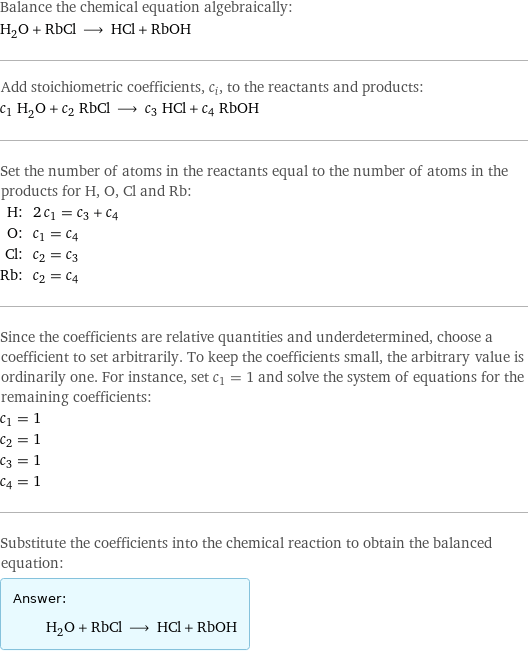
Balance the chemical equation algebraically: H_2O + RbCl ⟶ HCl + RbOH Add stoichiometric coefficients, c_i, to the reactants and products: c_1 H_2O + c_2 RbCl ⟶ c_3 HCl + c_4 RbOH Set the number of atoms in the reactants equal to the number of atoms in the products for H, O, Cl and Rb: H: | 2 c_1 = c_3 + c_4 O: | c_1 = c_4 Cl: | c_2 = c_3 Rb: | c_2 = c_4 Since the coefficients are relative quantities and underdetermined, choose a coefficient to set arbitrarily. To keep the coefficients small, the arbitrary value is ordinarily one. For instance, set c_1 = 1 and solve the system of equations for the remaining coefficients: c_1 = 1 c_2 = 1 c_3 = 1 c_4 = 1 Substitute the coefficients into the chemical reaction to obtain the balanced equation: Answer: | | H_2O + RbCl ⟶ HCl + RbOH
Structures

+ ⟶ +
Names

water + rubidium chloride ⟶ hydrogen chloride + rubidium hydroxide
Reaction thermodynamics
Enthalpy
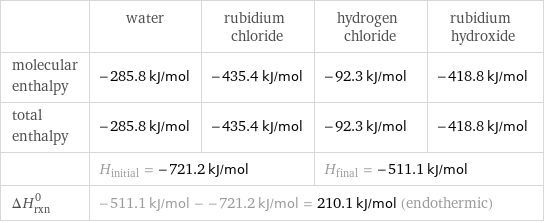
| water | rubidium chloride | hydrogen chloride | rubidium hydroxide molecular enthalpy | -285.8 kJ/mol | -435.4 kJ/mol | -92.3 kJ/mol | -418.8 kJ/mol total enthalpy | -285.8 kJ/mol | -435.4 kJ/mol | -92.3 kJ/mol | -418.8 kJ/mol | H_initial = -721.2 kJ/mol | | H_final = -511.1 kJ/mol | ΔH_rxn^0 | -511.1 kJ/mol - -721.2 kJ/mol = 210.1 kJ/mol (endothermic) | | |
Gibbs free energy
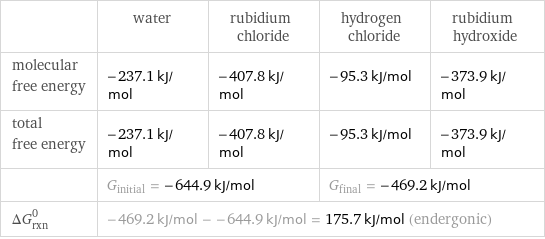
| water | rubidium chloride | hydrogen chloride | rubidium hydroxide molecular free energy | -237.1 kJ/mol | -407.8 kJ/mol | -95.3 kJ/mol | -373.9 kJ/mol total free energy | -237.1 kJ/mol | -407.8 kJ/mol | -95.3 kJ/mol | -373.9 kJ/mol | G_initial = -644.9 kJ/mol | | G_final = -469.2 kJ/mol | ΔG_rxn^0 | -469.2 kJ/mol - -644.9 kJ/mol = 175.7 kJ/mol (endergonic) | | |
Equilibrium constant
![Construct the equilibrium constant, K, expression for: H_2O + RbCl ⟶ HCl + RbOH Plan: • Balance the chemical equation. • Determine the stoichiometric numbers. • Assemble the activity expression for each chemical species. • Use the activity expressions to build the equilibrium constant expression. Write the balanced chemical equation: H_2O + RbCl ⟶ HCl + RbOH Assign stoichiometric numbers, ν_i, using the stoichiometric coefficients, c_i, from the balanced chemical equation in the following manner: ν_i = -c_i for reactants and ν_i = c_i for products: chemical species | c_i | ν_i H_2O | 1 | -1 RbCl | 1 | -1 HCl | 1 | 1 RbOH | 1 | 1 Assemble the activity expressions accounting for the state of matter and ν_i: chemical species | c_i | ν_i | activity expression H_2O | 1 | -1 | ([H2O])^(-1) RbCl | 1 | -1 | ([RbCl])^(-1) HCl | 1 | 1 | [HCl] RbOH | 1 | 1 | [RbOH] The equilibrium constant symbol in the concentration basis is: K_c Mulitply the activity expressions to arrive at the K_c expression: Answer: | | K_c = ([H2O])^(-1) ([RbCl])^(-1) [HCl] [RbOH] = ([HCl] [RbOH])/([H2O] [RbCl])](../image_source/4bd1699ff1cf5fdc2c6925007b25b10a.png)
Construct the equilibrium constant, K, expression for: H_2O + RbCl ⟶ HCl + RbOH Plan: • Balance the chemical equation. • Determine the stoichiometric numbers. • Assemble the activity expression for each chemical species. • Use the activity expressions to build the equilibrium constant expression. Write the balanced chemical equation: H_2O + RbCl ⟶ HCl + RbOH Assign stoichiometric numbers, ν_i, using the stoichiometric coefficients, c_i, from the balanced chemical equation in the following manner: ν_i = -c_i for reactants and ν_i = c_i for products: chemical species | c_i | ν_i H_2O | 1 | -1 RbCl | 1 | -1 HCl | 1 | 1 RbOH | 1 | 1 Assemble the activity expressions accounting for the state of matter and ν_i: chemical species | c_i | ν_i | activity expression H_2O | 1 | -1 | ([H2O])^(-1) RbCl | 1 | -1 | ([RbCl])^(-1) HCl | 1 | 1 | [HCl] RbOH | 1 | 1 | [RbOH] The equilibrium constant symbol in the concentration basis is: K_c Mulitply the activity expressions to arrive at the K_c expression: Answer: | | K_c = ([H2O])^(-1) ([RbCl])^(-1) [HCl] [RbOH] = ([HCl] [RbOH])/([H2O] [RbCl])
Rate of reaction
![Construct the rate of reaction expression for: H_2O + RbCl ⟶ HCl + RbOH Plan: • Balance the chemical equation. • Determine the stoichiometric numbers. • Assemble the rate term for each chemical species. • Write the rate of reaction expression. Write the balanced chemical equation: H_2O + RbCl ⟶ HCl + RbOH Assign stoichiometric numbers, ν_i, using the stoichiometric coefficients, c_i, from the balanced chemical equation in the following manner: ν_i = -c_i for reactants and ν_i = c_i for products: chemical species | c_i | ν_i H_2O | 1 | -1 RbCl | 1 | -1 HCl | 1 | 1 RbOH | 1 | 1 The rate term for each chemical species, B_i, is 1/ν_i(Δ[B_i])/(Δt) where [B_i] is the amount concentration and t is time: chemical species | c_i | ν_i | rate term H_2O | 1 | -1 | -(Δ[H2O])/(Δt) RbCl | 1 | -1 | -(Δ[RbCl])/(Δt) HCl | 1 | 1 | (Δ[HCl])/(Δt) RbOH | 1 | 1 | (Δ[RbOH])/(Δt) (for infinitesimal rate of change, replace Δ with d) Set the rate terms equal to each other to arrive at the rate expression: Answer: | | rate = -(Δ[H2O])/(Δt) = -(Δ[RbCl])/(Δt) = (Δ[HCl])/(Δt) = (Δ[RbOH])/(Δt) (assuming constant volume and no accumulation of intermediates or side products)](../image_source/f8f23d14857551978fb3774262d3694d.png)
Construct the rate of reaction expression for: H_2O + RbCl ⟶ HCl + RbOH Plan: • Balance the chemical equation. • Determine the stoichiometric numbers. • Assemble the rate term for each chemical species. • Write the rate of reaction expression. Write the balanced chemical equation: H_2O + RbCl ⟶ HCl + RbOH Assign stoichiometric numbers, ν_i, using the stoichiometric coefficients, c_i, from the balanced chemical equation in the following manner: ν_i = -c_i for reactants and ν_i = c_i for products: chemical species | c_i | ν_i H_2O | 1 | -1 RbCl | 1 | -1 HCl | 1 | 1 RbOH | 1 | 1 The rate term for each chemical species, B_i, is 1/ν_i(Δ[B_i])/(Δt) where [B_i] is the amount concentration and t is time: chemical species | c_i | ν_i | rate term H_2O | 1 | -1 | -(Δ[H2O])/(Δt) RbCl | 1 | -1 | -(Δ[RbCl])/(Δt) HCl | 1 | 1 | (Δ[HCl])/(Δt) RbOH | 1 | 1 | (Δ[RbOH])/(Δt) (for infinitesimal rate of change, replace Δ with d) Set the rate terms equal to each other to arrive at the rate expression: Answer: | | rate = -(Δ[H2O])/(Δt) = -(Δ[RbCl])/(Δt) = (Δ[HCl])/(Δt) = (Δ[RbOH])/(Δt) (assuming constant volume and no accumulation of intermediates or side products)
Chemical names and formulas
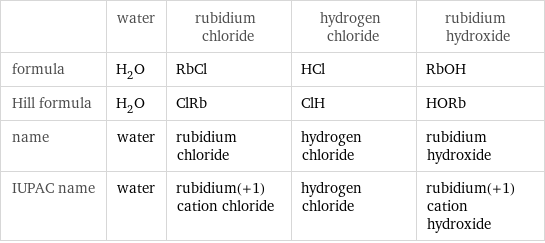
| water | rubidium chloride | hydrogen chloride | rubidium hydroxide formula | H_2O | RbCl | HCl | RbOH Hill formula | H_2O | ClRb | ClH | HORb name | water | rubidium chloride | hydrogen chloride | rubidium hydroxide IUPAC name | water | rubidium(+1) cation chloride | hydrogen chloride | rubidium(+1) cation hydroxide
Substance properties
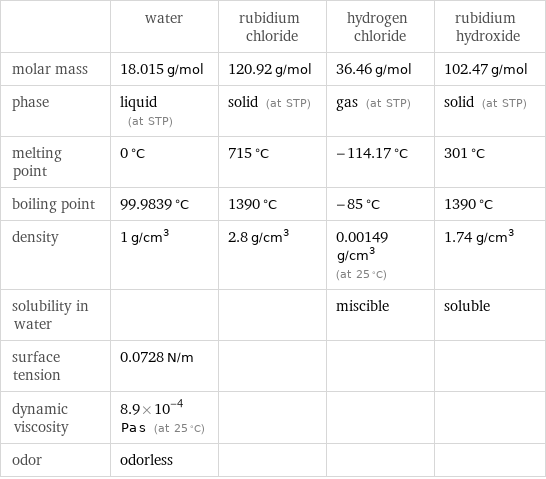
| water | rubidium chloride | hydrogen chloride | rubidium hydroxide molar mass | 18.015 g/mol | 120.92 g/mol | 36.46 g/mol | 102.47 g/mol phase | liquid (at STP) | solid (at STP) | gas (at STP) | solid (at STP) melting point | 0 °C | 715 °C | -114.17 °C | 301 °C boiling point | 99.9839 °C | 1390 °C | -85 °C | 1390 °C density | 1 g/cm^3 | 2.8 g/cm^3 | 0.00149 g/cm^3 (at 25 °C) | 1.74 g/cm^3 solubility in water | | | miscible | soluble surface tension | 0.0728 N/m | | | dynamic viscosity | 8.9×10^-4 Pa s (at 25 °C) | | | odor | odorless | | |
Units
